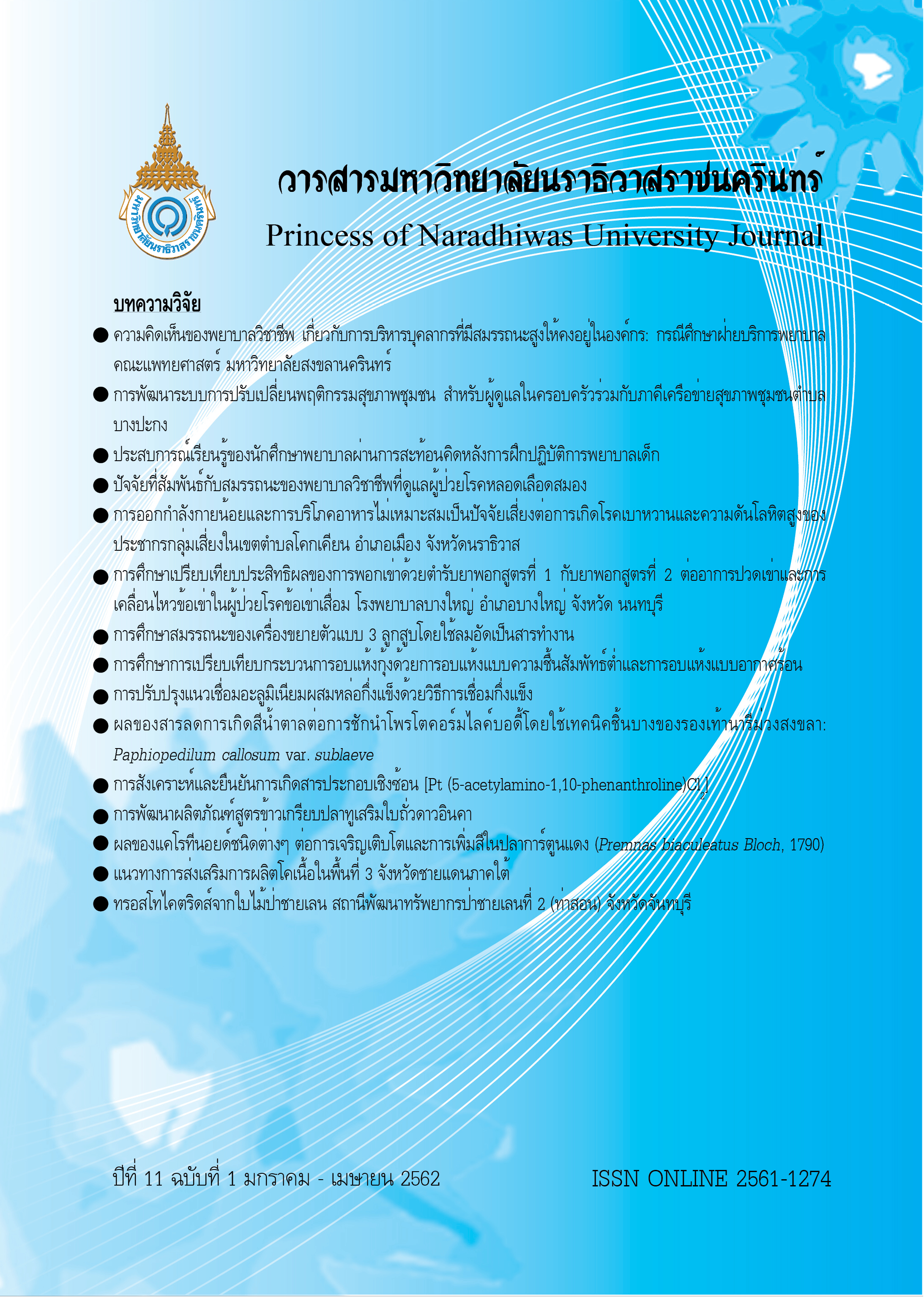The Comparative Study of Shrimp Drying Process with Low Humidity Air and Hot Air Drying
-
Keywords:
Hot Air Drying, Low Relative Humidity Air Drying, ShrimpAbstract
The objectives of this research were to investigate the factors that affect the drying process
of shrimp by using Relative Humidity Air Drying method compared with Hot Air Drying. Resilience,
water activity, and other variables, were controlled by temperature and relative humidity control in a
low humidity drying room at 30 oC and 35 - 55% Rh, respectively, while the hot air drying process
was carried out at 40, 50 and 60 oC. The physical properties of the shrimp such as color, hardness,
texture, temperature, and moisture content, were determined. Drying with hot air using a drying temperature of 60 oC took a minimum of 150 minutes to dry. The final moisture content of the shrimp was
13.51 (% d.b). The brightness was 49.52 ± 2.01, compared to other drying methods, for which values were not significantly different (p <0.05). It was found that hot air drying had the highest hardness
value (154.33 N), along with a low relative humidity of 118 N for water activity, in the range of 0.5-0.6,
which was not higher than the standard for product (136/2558) set by Thai Industrial Standards Institute.
References
Chen, H.E. & Peng, H.Y. (1995). Changes of carotenoids, color and vitamin A contents during processing of carrot juice. Journal of Agricultural and Food Chemistry, 43, 1912-1918.
Chungcharoen T., Prachayawarakorn S., Tungtrakul P. & Soponronnarit S., (2015). Effects of germination time and drying temperature on drying characteristics and quality of germinationpaddy. Food and Bioproducts Processing, 94, 707-716.
Janjai, S., Lamlert, N., Intawee, P., Mahayothee, B., Bala, B.K., Nagle, M. & Muller, L. (2009). Solar drying of peeled longan using a side loading type solar tunnel dryer: Experimental and simulated performance. Drying Technology, 27, 595-605.
Kasikorn research center. (2017). Trends, Opportunities and Strategies for Businesses under Global Fisheries Law with Thailand 4.0. (in Thai)
Moungthong, G., Klamkam, P., Mahakit, P., Chalermwatanachai, T., Sudaluk, T. & Monyakul, V. (2014). Efficacy
of the Precise Climate Controller on the reduction of indoor microorganism. Asia Pacific Allergy.
Nagaya, K., Li, Y., Jin, Z., Fukumuro, M., Ando, Y. & Akaishi, A. (2006). Low-temperature desiccant based food drying system with airflow and temperature control. Journal of Food Engineering, 75, 74-77.
Nathakaranakule A., Jaiboon P. & Soponronnarit S. (2010). Far-infrared radiation assisted Drying of longan fruit. Journal of Food Engineering, 100, 662-668.
Office of Commercial Affairs, Royal Thai Embassy WTC The Hague. (2014). Thai seafood and Thai seafood market in European market.
Rodpraphat, W., Jaekham, S., Vinitnanthakit, K. & Nunchai, W. (2010). Seafood drying using superheated steam Energy Technology. Faculty of Science and Technology Rajamangala University of Technology Tawan-ok. (in Thai)
Scott, W. J. (1957). Water relations of food spoilage microorganisms. Advances in Food Research, 7, 83-127
Smith, K.L. & Guentzel, J.L. (2010). Mercury concentrations and omega-3 fatty acids in fish and shrimp: preferential consumption for maximum health benefits. Marine Pollution Bulletin, 60(9), 1615-1618.
Sookchaiya, T., Monyakul, V. & Thepa, S. (2010). Assessment of the thermal environment effects on human comfort and health for the development of novel air Conditioning system in tropical regions. Energy and Buildings, 42, 1692-1702.
Thai Frozen Foods Association. (2016). Thailand Seafood Industry Overview. Bangkok: Thai Frozen Foods Association.
Tirawanichakul, S., Naphatthalung, W., & Tirawanichakul, Y. (2008). Drying strategy of shrimp using hot air convection and hybrid infrared radiation/hot air convection. Walailak Journal of Science and Technology, 5, 77-100




